When there is a conflict between two published lists of requirements, such as Boy Scout Requirements (BSA Publication No. 33215) and a Merit Badge Pamphlet, the requirements book should be considered to be the controlling document, until a newer edition of Boy Scout Requirements is issued.
BSA has been updating ALL of the merit badge pamphlets over the past few years. As of January 1, 2008, only 4 of the pamphlets have editions issued before January 1, 2000 and the requirements for only 8 merit badges have remained completely unchanged during that period. As new pamphlets are issued, when they contain new requirements, Scouts will have the option of starting with the new requirements as soon as the pamphlets are issued, or they may start work using the old requirements until the next edition of Boy Scout Requirements is issued.
BSA will NOT hold the publications of merit badge pamphlets until January each year. Instead, they will issue them as they are completed (and old stocks are exhausted, probably). Then in January, the requirements book will include all revisions to date.
Those Scouts working on any merit badges using the old requirements and who started before the new books were issued may complete the badge using the old requirements. Those starting work on a merit badge must use the new requirements. For RANK requirement changes, Scouts must normally meet the CURRENT requirements when they are ready for their Board of Review, unless special rules apply (as was the case for the change in First Class requirements in 2006).
The following Ranks, Merit Badges, and other awards have totally new or modified requirements listed in the 2008 edition of Boy Scout Requirements. Note that many of these actually appeared in Merit Badge Pamphlets issued during 2007 after the release of the 2007 edition of Boy Scout Requirements.
REVISED RANK REQUIREMENTS
Tenderfoot
Second Class
First Class
Star (not listed in the book - see below)
Life (not listed in the book - see below)
Eagle (not listed in the book - see below)
Eagle Scout - Alternate Requirements
REVISED MERIT BADGE REQUIREMENTS
Backpacking
First Aid
Graphic Arts (not listed in the book - see below)
Hiking
Metalwork
Sculpture
Water Sports (REPLACED
Waterskiing)
Wilderness Survival
OTHER AWARDS
Leave No Trace Achievement Awareness Award
Merit Badge Library
In the revisions below, where the requirements weren't
completely rewritten, the wording changes are shown as follows:
New text is in bold GREEN underlined Serif text like this
sentence.
Deleted portions are struck through RED italic text like
this sentence.
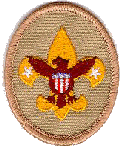 Tenderfoot
Tenderfoot
Requirements 9 and 12 were changed to read as follows:
- Explain why we use the buddy system in Scouting. Explain the importance of the buddy system as it relates to your personal safety on outings and in your neighborhood. Describe what a bully is and how you should respond to one.
-
- Demonstrate how to care for someone who is choking the Heimlich maneuver and tell when it is used.
- Show first aid for the following:
- Simple cuts and scrapes scratches
- Blisters on the hand and foot
- Minor (thermal/heat) burns or scalds (superficial, or first degree)
- Bites and stings of insects and tick
- Venomous Poisonous snakebite
- Nosebleed
- Frostbite and sunburn
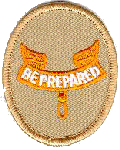 Second
Class
Second
Class
Minor wording changes were made to requirements 6a &
6cRequirement 8 became 8a, and a new requirement 8b was added.
Requirements 6 & 8 now read as follows:
-
- Show what to do for "hurry" cases of stopped breathing, serious bleeding, and internal ingested poisoning.
- Prepare a personal first aid kit to take with you on a hike.
- Demonstrate first aid for the following:
- Object in the eye
- Bite of a suspected rabid animal
- Puncture wounds from a splinter, nail, and fishhook
- Serious burns (partial thickness, or second degree)
- Heat exhaustion
- Shock
- Heatstroke, dehydration, hypothermia, and hyperventilation
- Participate in a school, community,
or troop program on the dangers of using drugs, alcohol, and tobacco,
and other practices that could be harmful to your health. Discuss your
participation in the program with your family.
- Participate in a school, community, or troop program on the dangers of using drugs, alcohol, and tobacco, and other practices that could be harmful to your health. Discuss your participation in the program with your family.
- Explain the three R's of personal safety and protection.
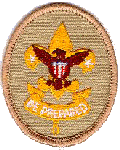 First
Class
First
Class
A minor wording change was made to requirement 8d
A new Requirement 12 was added, and old requirements 12 & 13 were renumbered
as 13 & 14. New Requirements 8d, and 12-14 read as follows:
- d. Tell the five most common signs signals of a heart attack. Explain the steps (procedures) in cardiopulmonary resuscitation (CPR).
- Describe the three things you should avoid doing related to use of the Internet. Describe a cyberbully and how you should respond to one.
- 12. Participate in a Scoutmaster conference.
- 13. Complete your board of review.
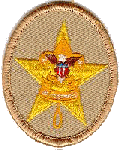 Star
Star
The list of eligible positions for Venturers should have been changed to add four new positions - Quartermaster, Historian, Den Chief, and Guide. This change does not appear in the book, but we have confirmed with the staff of the BSA National Director of Boy Scout Advancement that these positions are acceptable for advancement to Star and Life.
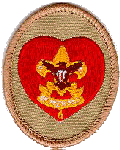 Life
Life
The list of eligible positions for Venturers should have been changed to add four new positions - Quartermaster, Historian, Den Chief, and Guide. This change does not appear in the book, but we have confirmed with the staff of the BSA National Director of Boy Scout Advancement that these positions are acceptable for advancement to Star and Life.
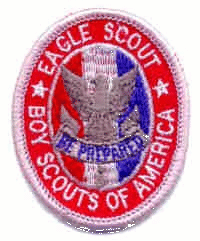 Eagle
Eagle
Additional wording was added to Requirement 2 in Boy Scout Requirements 2005, and that wording appeared in subsequent editions as well. We did not notice the change until 2008. (The requirement for references had, of course, appeared on the Application for Eagle Scout for a number of years, so there really was no effective change to that requirement.)
The list of eligible positions for Venturers in requirement 4 was changed in 2008 to add three new positions - Quartermaster, Historian, and Guide. This change is not noted in the list of changes on the inside front cover, but had been announced by BSA in early 2007, and the current Application form does also list these positions.
The list of eligible positions for Venturers should also have been changed to add the position of Den Chief. This change does not appear in the book, but Den Chief is listed on the current Eagle Scout Application. We have confirmed with the staff of the BSA National Director of Boy Scout Advancement that this position is acceptable for advancement to Eagle as well.
The list of eligible positions for Varsity Scouts should have been changed to add the position of Historian. This change does not appear in the book nor on the current Eagle Scout Application, but the position has been listed for advancement to Star and Life for some time. We have confirmed with the staff of the BSA National Director of Boy Scout Advancement that this position is acceptable for advancement to Eagle as well.
Note that neither the 2005 nor the 2008 editions of Boy Scout Requirements listed Eagle Scout as having any requirements changes in the lists on the inside front cover of the book.
The wording in requirement 5 (The Leadership Service Project) regarding who may be the beneficiary of the project varies in the 2008 Boy Scout Requirements Book (33215), Eagle Application Form (58-728), Project Workbook (18-927), and Advancement Committee Policies and Procedures (33088). We have confirmed with the BSA National Director of Boy Scout Advancement that the wording will be standardized to use that in Advancement Committee Policies and Procedures: “…a service project benefiting any religious institution, school, or community.”
Requirements 2, 4, and 5 should now read as follows:
- Demonstrate Scout spirit by living the Scout Oath (Promise) and Scout Law in your everyday life. List the names of individuals who know you personally and would be willing to provide a recommendation on your behalf, including parents/guardians, religious, educational, and employer references.
- While a Life Scout, serve actively for a period of 6 months
in one or more of the following positions of responsibility:
Boy Scout troop. - Patrol leader,
- assistant senior patrol leader,
- senior patrol leader,
- troop guide,
- Order of the Arrow troop representative,
- den chief,
- scribe,
- librarian,
- historian,
- quartermaster,
- junior assistant Scoutmaster,
- chaplain aide, or
- instructor.
Varsity Scout team. - Captain,
- cocaptain,
- program manager,
- squad leader,
- team secretary,
- Order of the Arrow team representative,
- librarian,
- quartermaster,
- chaplain aide,
- historian,*
- instructor,or
- den chief.
*Historian is not listed as an eligible position for Varsity Scouts in the 2008 edition of Boy Scout Requirements, nor on the current Eagle Scout Application, but we have confirmed with the staff of the BSA National Director of Boy Scout Advancement that this position is acceptable for advancement to Eagle.
Venturing crew / Sea Scout ship. - President,
- vice president,
- secretary,
- treasurer,
- quartermaster,
- historian,
- guide,
- den chief,*
- boatswain,
- boatswain's mate,
- yeoman,
- purser, or
- storekeeper
*Den Chief is not listed as an eligible position for Venturers in the 2008 edition of Boy Scout Requirements, but is listed on the current Eagle Scout Application. We have confirmed with the staff of the BSA National Director of Boy Scout Advancement that this position is acceptable for advancement to Eagle.
- While a Life Scout, plan, develop, and give leadership to others in a service project helpful to any religious institution, any school, or your community. (The project should benefit an organization other than Boy Scouting.) The project idea must be approved by the organization benefiting from the effort, your Scoutmaster and troop committee and the council or district before you start. You must use the Eagle Scout Leadership Service Project Workbook, BSA publication No. 18-927, in meeting this requirement.
Alternate Requirements for the Eagle Scout Badge
Old item 5 was deleted, and items 6-11 were renumbered as 5-10. The deleted requirement read as follows:
- The candidate must complete as many
of the requirements of the required merit badges as his ability permits.
 Backpacking
Backpacking
Minor changes were made to the wording of requirements 1, 6b, 8d, 9a, 10, 11a, 11b, and 11c.
Requirement 7 was rewritten, eliminating item 7b.
New requirements 3c, 4c and 6c were added.
The changes to the requirements read as follows:
- Show that you know first aid for injuries or illnesses that could occur Discuss the prevention of and treatment for the health concerns that could occur while backpacking, including hypothermia, heat reactions, frostbite, dehydration, insect stings, tick bites, snakebite, and blisters.
-
- Tell how you would minimize risk on a backpacking trek.
-
- Tell what factors are important in choosing a campsite.
-
- While on a trek, use a map and compass to establish your position on the ground at least three times at three different places, OR use a GPS receiver unit to establish your position on a topographic map and on the ground at least three times at three different places.
- Explain how to stay found, and what to do if you get lost.
- Do the following:
a. Tell how to prepare properly for and deal with inclement weather while on a backpacking trek.
b. Tell how to properly prepare for and deal with the human and environmental hazards you may encounter on a backpacking trek. -
- Demonstrate that you know how to keep cooking and eating gear clean and sanitary , and that you practice proper methods for food storage while on a backpacking trek.
-
- Write a plan for a patrol backpacking hike that includes a time control plan schedule.
- Using Leave No Trace principles, participate in at least three backpacking treks of at least three days each and at least 15 miles each, and using at least two different campsites on each trek. Carry everything you will need throughout the trek.
- Do the following:
- Write a plan for a backpacking trek of at least five days using at least three different campsites and covering at least 30 miles. Your plan must include a description of and route to the trek area, a schedule (including a daily time control plan schedule), a list of food and equipment needs, a safety and emergency plan, and a budget.
- Using Leave No Trace principles, take the trek you have planned and, while on the trek, complete at least one service project approved by your merit badge counselor.
- Upon your return, write a report about the trek Keep a daily journal during the trek that includes a day-by-day description of what you did or what happened, and what you might do the same and what you might do differently on your your activities, including notes about what worked well and thoughts about improvements that could be made for the next trek.
 First
Aid
First
Aid
In requirement 2, new items b and c were added, and old item b was renumbered as item d.
In requirement 3, item a was revised, items b and c were combined, a new item c was added, and item d was slightly revised.
In requirement 4, minor changes were made to items a and b.
In requirement 6, there are now three items. Scouts must do TWO of them. Item a was slightly changed, and a new item c was added.
The changes to the requirements read as follows:
- Do the following:
- Explain the term triage.
- Explain the standard precautions as applied to bloodborne pathogens.
- b. Prepare a first aid kit for your home. Display and discuss its contents with your counselor.
- Do the following:
- Explain what action you should take for someone who shows signs signals of shock, for someone who shows signals of a heart attack, and for someone who shows signals of stroke.
- Identify the conditions that must exist before performing CPR on a person. Then demonstrate proper technique in performing CPR using a training device approved by your counselor.
- Demonstrate proper technique in performing
CPR using a training device approved by your counselor.
Explain the use of an automated external defibrillator (AED). - Show the steps that need to be taken for someone suffering from a severe cut laceration on the leg and on the wrist. Tell the dangers in the use of a tourniquet and the conditions under which its use is justified.
- Do the following:
- Describe the signs signals of a broken bone. Show first aid procedures for handling fractures (broken bones), including open (compound) fractures of the forearm, wrist, upper leg, and lower leg using improvised materials.
- Describe the symptoms and possible complications and demonstrate proper procedures for treating suspected injuries to the back, neck, and head head, neck, and back. Explain what measures should be taken to reduce the possibility of further complicating these injuries.
- Do TWO of the following:
- If a sick or injured person must be moved, tell how you would determine the best method. Demonstrate this method.
- With helpers under your supervision, improvise a stretcher and move a presumably unconscious person.
- With your counselor's approval, arrange a visit with your patrol or troop to an emergency medical facility or through an American Red Cross chapter for a demonstration of how an AED is used.
 Graphic
Arts
Graphic
Arts
The requirements for this badge were revised with publication of a new Graphic Arts merit badge pamphlet (33374B) during 2006. However, these revised requirements were omitted from Boy Scout Requirements 2007 and 2008 (33215), which still shows the old requirements. Scouts may use either set of requirements until BSA corrects the error in the next edition. We have confirmed this with the staff of the BSA National Director of Boy Scout Advancement.
Changes were made to requirements 1, 2, 3, 4a, 4b, & 4c. Items 7 became 6 & 7, with changes to 6b & 6d. Old Item 6 became item 7 and was rewritten.
The changes to the requirements read as follows:
- Review with your counselor the processes for producing printed communications: offset lithography, screen process printing, electronic/digital, relief, and gravure. You may show Collect samples of three products, each one produced using a different printing process, or draw diagrams to help with your description.
- Explain the differences between continuous-tone, line, and halftone artwork. Describe how it can be created and/or stored in a computer.
- Design a printed piece (flier, T-shirt, program, form, etc.) and produce it. Explain your decisions for the typeface or typefaces you use and the way you arrange the elements in your design. Explain which printing process is best suited for printing your design. If desktop publishing is hardware and software are available, identify what hardware and software would be appropriate for outputting your design.
-
- Offset lithographyy
Make a layout and then produce a plate using a process approved by your counselor. Run the plate and print at least 50 copies. - Screen process printing
Make a hand-cut or photographic stencil and attach it to a screen that you have prepared. Mask the screen and print at least 20 copies. - Electronic/digital printing
Using both text and graphics, create Make a layout in electronic form, download it to the press or printer, and run 50 copies. If no electronic interface to the press or printer is available, you may print and scan a paper copy of the layout.
- Offset lithographyy
- Identify three career opportunities
in graphic arts and tell how you can prepare for them.
7. Do ONE of the following, and then describe the highlights of your visit:- Visit a newspaper printing plant: Follow a story from the editor to the press.
- Visit a retail, commercial, or in-plant printing facility: Follow a project job from beginning to end.
- Visit a school’s graphic arts program: Find out what courses are available and what the prerequisites are.
- Visit three Web sites (with your parent’s permission) on the Internet that belong to graphic arts professional organizations and/or printing-related companies (suppliers, manufacturers, printers): With permission from your parent or counselor, print out or download Download product or service information from two of the sites.
- Find out about three career opportunities in graphic arts. Pick one and find out the education, training, and experience required for this profession. Discuss this with your counselor, and explain why this profession might interest you.
 Hiking
Hiking
A minor change to the wording of requirement 7 was made. It now reads:
- After each of the hikes (or during each hike if on a one continuous "trek") in requirements 5 and 6, write a short report of your experience. Give dates and descriptions of routes covered, the weather, and interesting things you saw. Share this report with your merit badge counselor.
 Metalwork
Metalwork
All of the requirements were rewritten.
The changes to the requirements read as follows:
- Read the safety rules for metalwork listed in the Metalwork merit badge pamphlet. Describe to your counselor Discuss how to be safe while working with metal. Because this merit badge offers four options, show your counselor which additional safety rules apply to the discipline you choose and discuss them with your counselor. Discuss with your counselor the additional safety rules that apply to the metalwork option you choose for requirement 5.
- Define the terms native metal, malleable, metallurgy,
alloy, nonferrous, and ferrous. Then do Do
the following:
- Define the term native metal.
b. Define the term malleable.
c. Define the term metallurgy.
d. Define the term alloy.
e. Name two nonferrous alloys used by pre-Iron Age metalworkers. Name, and name the metals that are combined to form these alloys. - f. Explain the term ferrous, and name Name three ferrous alloys used by modern metalworkers.
- g. Describe how to work–harden a metal.
- h. Describe how to anneal a non-ferrous and a ferrous metal.
- Define the term native metal.
- Do the following:
- Work-harden a piece of 26- or 28-gauge sheet brass or sheet copper. Put a 45-degree bend in a small piece of 26- or 28-gauge sheet brass or sheet copper the metal, then heavily peen the area along the bend line to work-harden it. Note the amount of effort that is required to overcome the yield point in this unworked piece of metal.
- Work-harden another piece of the same sheet
brass or sheet copper. and then put a 45-degree bend in it. Note
the amount of effort that is required to overcome the yield point.
c. Soften the same bent, work hardened piece from requirement 3a by annealing it and then try to remove the 45–degree bend. Note the amount of effort that is required to overcome the yield point. - Make a temper color index from a flat piece
of steel. Using hand tools, make and temper a center punch of medium-carbon
or high-carbon steel.
d. Join two small pieces of scrap metal using a hammered rivet. Repeat the process using a pop rivet.
e. Using a flatlock seam, join two pieces of scrap metal together with either lead-free solder or silver solder.
f. Make a temper color index from a flat piece of steel. Using hand tools, make and temper a center punch of medium-carbon or high-carbon steel.
g. Using metal cans, practice using the basic metalworking tools and techniques by making at least two tasteful objects that require cutting, bending, and edging.
- Find out about three career opportunities in metalworking.
Pick one and find out the education, training, and experience required
for this profession. Discuss this with your counselor, and explain why
this profession might interest you.
Do ONE of the following:- Visit an experienced sheet metal mechanic, tinsmith, coppersmith, jeweler, founder or a blacksmith at his or her workshop. You may select a skilled hobbyist or a professional. Ask permission to see the tools used and to examine examples of the work made at the shop. Inquire about the level of education required to become an apprentice craftsman.
- If you have (or your counselor has) access
to the internet, explore metalworking occupations by conducting
a Web search. With your counselor’s help and guidance, find at least
five metalworking–related Web sites. Print a copy of the web pages
and discuss them with your counselor.
- When conducting your Web search, use keywords such as metallurgy, metalwork, spinning metal, metal fabrication, steel fabrication, aluminum fabrication, casting metal, pattern making, welding, forge welding, blacksmith, art metal, Artist Blacksmith Association of North America, farrier, brazing, goldsmith, machinist, or sheet metal mechanic.
- After completing the first four requirements, complete at least
ONE of the options listed below.
- Option 1 – Sheet Metal Mechanic / Tinsmith
- Name and describe the use of the basic sheet metalworking tools.
- Create a reasonably accurate sketch of two tasteful objects to make from sheet metal. Include each component's dimensions on your sketch, which need not be to scale.
- Make two objects out of 24- or 26–gauge
sheet metal. Use Using patterns
either provided either
by your counselor or made by you and approved
by your counselor. Construct these objects using a metal that
is appropriate to the object's ultimate purpose, and using cutting,
bending, edging, and either soldering or brazing.
, make at least two tasteful objects out of
24- or 26–gauge sheet metal. Use a metal that is appropriate
to the object’s ultimate purpose.
- Both objects must be constructed using
culling, bending, edging, and either soldering or brazing
b. One object also must include at least one riveted component - c. If you do not make your objects from zinc-plated sheet steel or tin-plated sheet steel, preserve your work from oxidation.
- Both objects must be constructed using
culling, bending, edging, and either soldering or brazing
- Option 2 - Silversmith
- Name and describe the use of a silversmith's the basic tools used by a silversmith.
- Create a reasonably accurate hand-drawn sketch of two tasteful objects to make from sheet silver. Include each component's dimensions on your sketch, which need not be to scale.
- Make two objects out of 8- or 20- gauge
sheet copper. Use Using patterns
either provided either
by your counselor or made by you and approved
by your counselor. Both objects must include a soldered joint.,
make at least two tasteful objects out of 18- or 20–gauge sheet
Copper. If you have prior silversmithing experience,
you may substitute sterling silver, nickel silver, or lead free
pewter.
- At least one object must include a sawed component you have made yourself.
- At least one object must include a sunken part you have
made yourself.
c. Both objects must include a soldered joint. - d. Clean and polish your objects.
- Option 3 – Founder
- Name and describe the use of the basic parts of a two–piece mold. Name at least three different types of molds.
- Create a reasonably accurate sketch of two tasteful objects to cast in metal. Include the height, width, and length on the sketch. Include each component's dimensions on your sketch, which need not be to scale.
- Do the following:
a. Using Make two molds, one using a pattern provided by your counselor and another one made by yourself, make two molds. you have made yourself that has been approved by your counselor. Position the pouring gate and vents yourself. Do not use copyrighted materials as patterns.
- b. Make Using lead-free pewter, make a casting using a mold provided by your counselor and make a casting using the mold you have made. Use lead free pewter when casting each mold.
- c. Remove all evidence of gates, vents,
and parting-line flash from your castings.
Using lead-free pewter, make a casting using the mold that you have made.
- Option 4 - Blacksmith
- Name and describe tell the use of a blacksmith's the basic tools used by a blacksmith.
- Make a reasonably accurate sketch of two tasteful objects to hot-forge. Include each component’s dimensions on your sketch, which need not be to scale.
- Using low–carbon steel at least ¼ inch thick, perform the
following exercises:
- Draw out by forging a taper.
- Use the horn of the anvil by forging a U-shaped bend.
- Form Twist steel by placing a decorative twist in a piece of square steel.
- Use the edge of the anvil to bend metal by forging an L–shaped bend.
- Using low-carbon steel at least ¼ inch thick, make
the at least
two tasteful objects
you sketched that require hot-forging.
Be sure you have your counselor's approval
before you begin.
- Include a decorative twist on one object.
- Include a hammer-riveted joint in one object.
- Preserve your work from oxidation.
- Preserve your work from oxidation.
- Option 1 – Sheet Metal Mechanic / Tinsmith
 Sculpture
Sculpture
Requirements 2 and 3 were rewritten.
The changes to the requirements read as follows:
- Do TWO of the following:
- Model in clay a life-sized human head. Then sculpt in modeling clay (such as Plastine or Sculpey) or carve/rasp in wood or soft stone a small-scale model of an animal or person. Explain to your counselor the method and tools you used to sculpt the figure.
- Sculpt in modeling clay (such as plasteline
or Sculpey) or carve/rasp in wood or soft stone a small scale model
of an animal or person.
Explain to your counselor the method and tools you used to sculpt the figure.
Make a plaster mold of a fruit or vegetable. In this mold make a copy of the fruit or vegetable. Explain to your counselor the method and tools you used to make the copy. - With your parent's permission and your counselor's approval, visit a museum, art exhibit, art gallery, artists' co-op, or artist's studio. After your visit, share with your counselor what you have learned. Discuss the importance of visual arts and how it strengthens social tolerance and helps stimulate cultural, intellectual, and personal development.
- Find out about career opportunities in sculpture.
Pick one and find out the education, training, and experience required
for this profession. Discuss this with your counselor, and explain why
this profession might interest you.
Do the following:- Make a plaster mold of a fruit or vegetable.
- In this mold make a copy of the fruit or vegetable.
Explain to your counselor the method and tools you used to sculpt the figure.
 Water
Sports
Water
Sports
The merit badge was renamed (from Waterskiing). Requirements 1, 3, 4, 5, 6, and 7 were revised, and requirements 8-11 deleted. Old requirement 6 became part of new requirement 7, and old requirements 7, 8, and 9 became parts of new requirement 6.
The revisions were as follows:
- Show that you know first aid for injuries or illnesses that could occur while waterskiing participating in water sports, including hypothermia, heat exhaustion, heatstroke, dehydration, sunburn, contusions, lacerations, minor cuts and blisters, and hyperventilation.
- Do the following:
- Identify the conditions that must exist before performing CPR on a person. Explain how such conditions are recognized.
- Demonstrate proper technique for performing CPR using a training device approved by your counselor.
- Before doing the following requirements, successfully complete the BSA swimmer test. Jump feetfirst into water over your head in depth. Level off, and swim 75 yards in a strong manner using one or more of the following strokes: sidestroke, breaststroke, trudgen, or crawl; then swim 25 yards using an easy, resting backstroke. The 100 yards must be completed in one swim without stops, and must include at least one sharp turn. After completing the swim, rest by floating.
- Know the Water-Skier's Safety Code. Promise that
you will live up to it. Follow it in all water work for this badge.
Know the safety precautions that must be used by the boat operator in
pulling skiers.
Do the following:- Discuss the BSA Safety Afloat policy. Tell how it applies to Water Sports.
- Name the different types of personal flotation devices (PFDs), and explain when each type should be used. Show how to choose and properly fit a PFD.
- Know the Water Sports Safety Code. Promise that you will live up to it and follow it in all water work for this badge. Know the safety precautions that must be used by the boat operator in pulling water-skiers and wakeboarders.
- Show the following water-skier signals to the safety observer in the boat: skier safe, faster, slower, turns, back to dock, cut motor, skier in water.
- In deep water, show you can adjust binders to
fit, put on skis, and recover skis that have come off during a fall.
Showing reasonable control while using two skis, one ski, or a wakeboard, do EACH of the following:- Show how to enter the water from a boat and make a deepwater start without help.
- Show you can cross both wakes four times and return to the center of the wake each time without falling.
- Show you can fall properly to avoid an obstacle. Also, show that you can drop handle and coast to a stop without loss of balance.
- Make a deepwater start on two skis without help.
While on shore, show that you know how to properly adjust the bindings on your ski(s) or wakeboard to fit yourself. Then, in deep water, show that you can adjust bindings to fit. Recover and put on your ski(s) or wakeboard that has come off during a fall. - Show you can fall properly to avoid an obstacle. Also, show that you can drop handle and coast to a stop without loss of balance.
- Show you can cross both wakes and return to center of wake without falling. Repeat three times.
- During a demonstration run, lift one ski clear of the water for two seconds. Then do the same with the other ski. Show that you are steady and comfortable on skis at all times.
- Ski on one ski for 30 seconds. Show reasonable control.
 Wilderness
Survival
Wilderness
Survival
Requirements 1-8 were revised. Requirement 9 was added to requirement 8, requirements 10-13 renumbered as 9-12 with some minor wording changes. The changes are as follows:
- Show that you know first aid for and how to prevent injuries or illnesses likely to occur in backcountry outings settings, including hypothermia, heatstroke, heat exhaustion heat reactions, frostbite, dehydration, sunburn blisters, insect stings, tick bites, snakebite, and blisters snakebites.
- Describe from From memory list the seven priorities for survival in a backcountry or wilderness location. Explain the importance of each one with your counselor.
- Describe ways to avoid panic and maintain a high
level of morale when lost, and explain why this is important.
- avoid panic and
- maintain a high level of morale when lost.
- Tell what you would do to survive in the following
environments:
Describe the steps you would take to survive in the following conditions:- Cold and snowy
- Wet (forest)
- Hot and dry (desert)
- Windy (mountains or plains)
- Water (ocean or lake , lake, or river)
- Make up Put together a personal survival kit and be able to explain how each item in it is could be useful.
- Show that you can start fires using Using three different methods (other than matches), build and light three fires.
- Do the following:
- Tell Show five different ways of attracting to attract attention when lost.
- Show Demonstrate how to use a signal mirror.
- Describe from memory five international ground-to- air signals and tell what they mean.
- Show that you can find and improvise Improvise a natural shelter. For the purpose of this demonstration, use techniques that have little negative impact on minimizing the damage to the environment. Spend a night in your shelter.
- Spend a night in your shelter.
Explain how to protect yourself from insects, reptiles, and bears. - Explain how to protect yourself against insects,
reptiles, and bears.
Demonstrate three ways to treat water found in the outdoors to prepare it for drinking. - Show three ways to treat water found in the outdoors
to prepare it for drinking.
Show that you know the proper clothing to wear in your area on an overnight in extremely hot weather and in extremely cold weather. - Show that you know the proper clothing to wear
in your area on an overnight in extremely hot weather and extremely
cold weather.
Explain why it usually is not wise to eat edible wild plants or wildlife in a wilderness survival situation. - Explain why it usually is not wise to eat edible wild plants or wildlife in a wilderness survival situation.
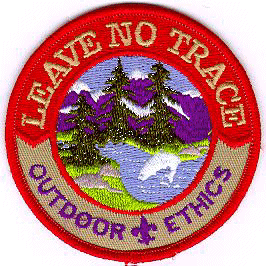 Leave
No Trace Achievement Awareness
Award
Leave
No Trace Achievement Awareness
Award
The award was renamed, requirements 1, 2, 4, & 5 were revised, and requirement 6 was replaced. The revisions to the requirements are as follows:
- Recite and explain in your own words the principles of Leave No Trace, and discuss how an ethical guideline differs from a rule.
- On three separate camping/backpacking trips with your troop or team, demonstrate and practice the principles of Leave No Trace skills appropriate to the trip.
- Participate in a Leave No Trace-related service project that reduces or rehabilitates recreational impacts. Discuss with your troop or team which recreational impacts were involved with the project.
- Give a 10-minute presentation on a Leave No Trace topic approved by your Scoutmaster unit leader to a Scouting unit or other interested group.
- Draw a poster or build a model to demonstrate the differences in how we camp or travel in high-use and pristine areas Teach a Leave No Trace-related skill to a Scouting unit or other interested group..
Merit Badge Library
The listing on the inside back cover has one error - the most recent edition of the Horsemanship merit badge pamphlet was issued in 2003, not 2004.
This analysis was prepared as a service to Scouts and
Scouters nationwide
Paul S. Wolf
Advancement Webmaster
US Scouting Service Project, Inc.
Printed copies of this document may be freely distributed for use in the Scouting program, so long as the source is acknowledged, but copying the information to another web site is NOT authorized.







